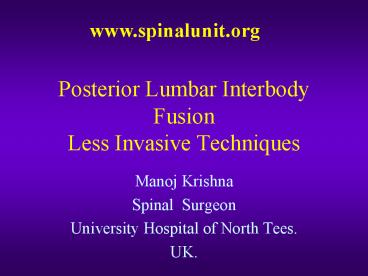Posterior Lumbar Interbody Fusion Less Invasive Techniques - PowerPoint PPT Presentation
1 / 36
Title:
Posterior Lumbar Interbody Fusion Less Invasive Techniques
Description:
Posterolateral vs PLIF in lytic Spondylo-listhesis. N=40 ... Better vascularity of graft. Especially in smokers. Chronic degeneration- thick endplates. ... – PowerPoint PPT presentation
Number of Views:1041
Avg rating:3.0/5.0
Title: Posterior Lumbar Interbody Fusion Less Invasive Techniques
1
Posterior Lumbar Interbody FusionLess Invasive
Techniques
www.spinalunit.org
- Manoj Krishna
- Spinal Surgeon
- University Hospital of North Tees.
- UK.
2
Principles of PLIF surgery
- Removal of Pain Source- Disc
- Restoring Normal Load Transmission across disc
- Neural decompression
- Restoring Lordosis
3
META-ANALYSIS OF FUSION. ESJ, 1997. BOOS AND
WEBB. n 5601
Good outcome
4
META-ANALYSIS OF FUSION
BOOS and WEBB
Fusion
()
AIF
PLF
PLIF
PLFIF
PLFPF
PLIFPF
5
META-ANALYSIS OF FUSION
BOOS and WEBB
AIF
PLF
PLIF
PLFIF
PLFPF
PLIFPF
6
Meta-Analysis of Fusion
Turner, Deyo et al. JAMA. 1992.
7
Posterolateral vs PLIF in lytic Spondylo-listhesis
- N40 posterolateral and 37 had PLIF added.
- 7.5 nonunion in PLF , none in PLIF
- 45 excellent results in PLF group
- 75 excellent results in PLIF group.
- 90 satisfied in both groups.
SUK et al, SPINE, 1997.
8
Positioning in PLIF Surgery
- Tummy MUST be free
- Use Knee chest position if obese
- Jackson table ideal
9
Minimising Blood Loss
- Positioning
- Hypotension-
- Reduce end-inspiratory pressure
- Sacral Epidural before surgery ?
- Flowseal topical coagulant.
10
Exposure
- Keep midline intact
- do not expose transverse
- process
- Remove facet joint
- Decompress the lateral
- recess above the disc
- Re-suture fascia to
- Inter-spinous ligament
11
Why total facetectomy?
- Decompress exiting nerve completely
- Provide space for cage
- Provide bone for grafting
- Remove possible pain source
12
Why insert cage laterally?
- Thickest bone laterally
- No need to retract nerve root
- Better load transmission
- More bone graft between cages
13
Getting the lateral disc out..
14
Why Bilateral Cage Insertion?
- Degenerative disc pain source- inflamatory
generators - A lot of postero-lateral disc left on opposite
side - Can insert largest cages to re-tension the annulus
15
Pedicle screw insertion
Burr just above pars. Just medial to mamillary
ridge No need to expose TP No muscle
stripping. Minimise exposure needed
16
Restoring Disc Height
- Release rim of disc- lateral and anterior
- Sequential spreaders on alternate sides
- Aim for 10mm height
- Stop when spreaders in tension
17
Restoring disc height
Tight lateral annulus
Disc
L5
S1
18
Cage size
- Use largest cage possible- 10mm or more in 90.
- Remove posterior lip osteophyte to make room for
cage insertion - Protect both traversing and exiting nerves during
cage insertion
19
Making room for cage
Medio-lateral slope
Lip
AP view of disc
Lateral view of disc
20
Disc Removal
- Key to success
- Shavers not good enough
- Use curettes on endplate
21
Perforate Endplate
- Make small holes in endplate
- Better vascularity of graft
- Especially in smokers
- Chronic degeneration- thick endplates.
22
Bone Graft
- Use morsellised local bone
- Mix with 10cc of Bone Marrow Aspirate
- Current Practise Do not take Iliac Crest Graft
23
Prevent late Nerve Pain
- Remove small bone fragments from around the nerve
- Free exiting nerve in lateral recess above
- Complete facetectomy
- Avoid too much nerve retraction
24
Current Practise
- Average time- 130 mins- single level
- Hospital stay- most stay 2 nights post-op
- Minimal exposure- 7cm incision
- Most report pre-operative pain is gone at
discharge.
25
Diagnosis
- Degenerative Disc Disease-- 61
- Spondylolysis/listhesis-- 22
- PostLaminectomy Syndrome--11
- Broad Based Disc Prolapse--7
26
Duration of Pre-operative symptoms 4
months to 23 years mean 86months
27
Hospital Stay 2 to 12 nights most often-2
nights
28
Follow-up 12 months to 60 months
29
Statistical Analysis(paired t-test)
- Low Back-pain VAS pre-op---7.68
- Low Back-pain VAS post-op---3.06
- 95 Confidence Interval 2.81-4.8
- P lt .0001
30
Statistical Analysis (paired t-test)
- Leg Pain VAS pre-op6.48
- Leg Pain VAS post-op2.86
- 95 Confidence Interval 2.44 - 4.79
- P lt .0001
31
Statistical Analysis (paired t-test)
- Oswestry Disability Index pre-op64.63
- Oswestry Disability Index post-op27.69
- 95 Confidence Interval 29.04 - 44.82
- P lt .0001
32
Results
- 82/101 Totally Pain free/Much Better.
- 11/101 No Better (2- significant Bone Graft
Pain). - 2 worse off ( 1 with a sensory level at T10, 1
with loss of bladder sensation) - 5/101 Lost to follow-up/moved out of area.
- 1/101 Deceased, medical reasons.
33
PLIF in Disc Prolapse ?
- Is disc going to fail ?
- 30-60 get intrusive LBP later.
- Which patients to select?
34
Indications for PLIF in Disc Prolapse
- Central Disc prolapse
- Broad based posterolateral disc prolapse
- Underlying advanced degeneration
- Long history of LBP prior to sciatic symptoms
- Severe leg pain with no sign of neural
compression
35
RS. M. 07/60. Greengrocer.
Intermittent LBP several years. Then Rt sciatica
LBP settled. Scoliotic tilt and stooped
forwards 40 degrees. Rt SLR40 L5 decreased
sensation ? Discectomy or PLIF ?
36
RS. M07/60. Greengrocer
June 2002- L4/5 PLIF Sept 2002 Back at work
doing heavy lifting. 100 pain relief. No leg
pain.































